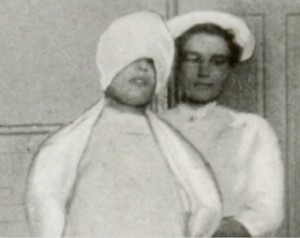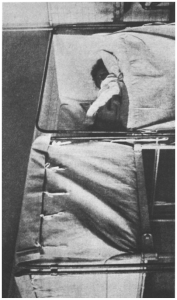A 30-day series of quotes spanning two hundred years ~ click here to begin with Day 1
You can also read the entire series as a single post
Day 6 ~ 1914
1914 ~ Twilight Sleep: Simple Discoveries in Painless Childbirth by Drs, H. Smith and J. Whitridge Williams, explaining why equal economic compensation between the sexes is not appropriate:
Have you ever considered,” he said, “the economical significance of the fact that three out of every five women are more or less incapacitated for several days each month, and that one of them is quite unable to attend to her duties?
Granting that the two sexes are possessed of equal intelligence, it means that women cannot expect to compete successfully with men. For until they are able to work under pressure for 30 days each month, they cannot expect the same compensation as the men who do so.”
1914 ~ Dr J. Whitridge Williams, additional quoted from his book “Twilight Sleep”
That word ‘physiological’ has all along stood as a barrier in the way of progress.
“…. the cultured woman of today has a nervous system that makes her far more susceptible to pain and to resultant shock than her more lethargic ancestor of remote generations
.… women of primitive and barbaric tribes appear to suffer comparatively little in labor, [while] civilized women of the most highly developed nervous or intellectual type who suffer most.
Even in this second decade of the 20th century, … women bring forth children in sorrow, quite after the ancient fashion, unsolaced by even single whiff of the beneficent anesthetic vapors through the use of which the agonies of tortured humanity may be stepped in the waters of forgetfulness.
Such a woman not unnaturally shrinks from the dangers and pains incident to child-bearing; yet such cultured women are precisely the individuals who should propagate the species and thus promote the interests of the race. Abnormal pain as an evolutionary threat to the [Caucasian] race. Considered from an evolutionary standpoint, the pains of labor appear not only uncalled for, but positively menacing to the race.
…… any trait or habit may be directly detrimental to the individual and to the race and they may be preserved, generation after generation, through the fostering influence of the hot-house conditions of civilized existence.
Everyone knows that the law of natural selection through survival of the fittest, which as Darwin taught us … does not fully apply to human beings living under the artificial conditions of civilization. These artificial conditions often determine that the less fit, rather than the most fit, individuals shall have progeny and that undesirable rather than the desirable qualities shall be perpetuated.”
The problem of making child-bearing a less hazardous ordeal and a far less painful one for these nervous and sensitive women is a problem that concerns not merely the women themselves, but the coming generations.
Let the robust, phlegmatic, nerveless woman continue to have her children without seeking the solace of narcotics or the special attendance of expert obstetricians, if she prefers. But let her not stand in the way of securing such solace and safety for her more sensitive sisters.
… every patient who goes to the hospital may have full assurance that she will pass through what would otherwise be a dreaded ordeal in a state of blissful unconsciousness (i.e. Twilight Sleep drugs of scopolamine and morphine)
“In Johns Hopkins Hospital,” said Dr Williams, “no patient is conscious when she is delivered of a child. She is oblivious, under the influence of chloroform or ether.”
Note: photo of enclosed ‘crib’ that women were confined to after receiving Twlight Sleep drugs. These special beds were cages so heavily medicated labor patients didn’t fall out of the bed.
The medal bars were padding so the mother-to-be would not get bruised as she banged around in the bed.
Some beds could be adjusted so the delivery could be conducted with taking the woman out of the caged enclosure.
1914 ~ Dr. JW Williams insisted that scopolamine narcosis of
women under Twilight Sleep drugs did not cause any damaging hypoxia in the fetus-neonate because neonatal respiratory depression, which delays breathing after it’s born, as actually advantageous to the newborn.
Quoted from the work of Professor Ludwig Aschoff, Dr J. Whitridge Williams explained:
“the tendency to retard respiration on the part of the child may sometimes be beneficial, preventing the infant from inhaling too early, thus minimizing the danger of strangulation from inhalation of fluids. … statistics of the Frauenklinik show that the percentage of infant mortality is low.
As against an infant mortality of 16 percent [160 baby deaths per 1,000 births] for the state of Baden, [Germany] in the same year a report on 421 ‘Twilight Sleep” babies showed a death-rate of [only]11.6 % [ 116 per 1,000]. For this strikingly low mortality of the children during and after birth under semi-narcosis, explanation was sought of Professor Ludwig Aschoff, the great German authority on morbid anatomy.

Extremely depressed baby born of mother who received the Twilight Sleep drugs of scopolamine and morphine during labor and general anesthesia for delivery. Note the empty umbilical cord no blood) at the moment of birth physician is clamping and cutting the cord)
He offered the theoretic explanation that slight narcotization of the respiratory organs during birth by extremely minute quantities of scopolamin[e] is advantageous to the child, as it tends to prevent permanent obstruction of the air-passage of children by premature respiration during birth.”
Day 7 ~ 1915




